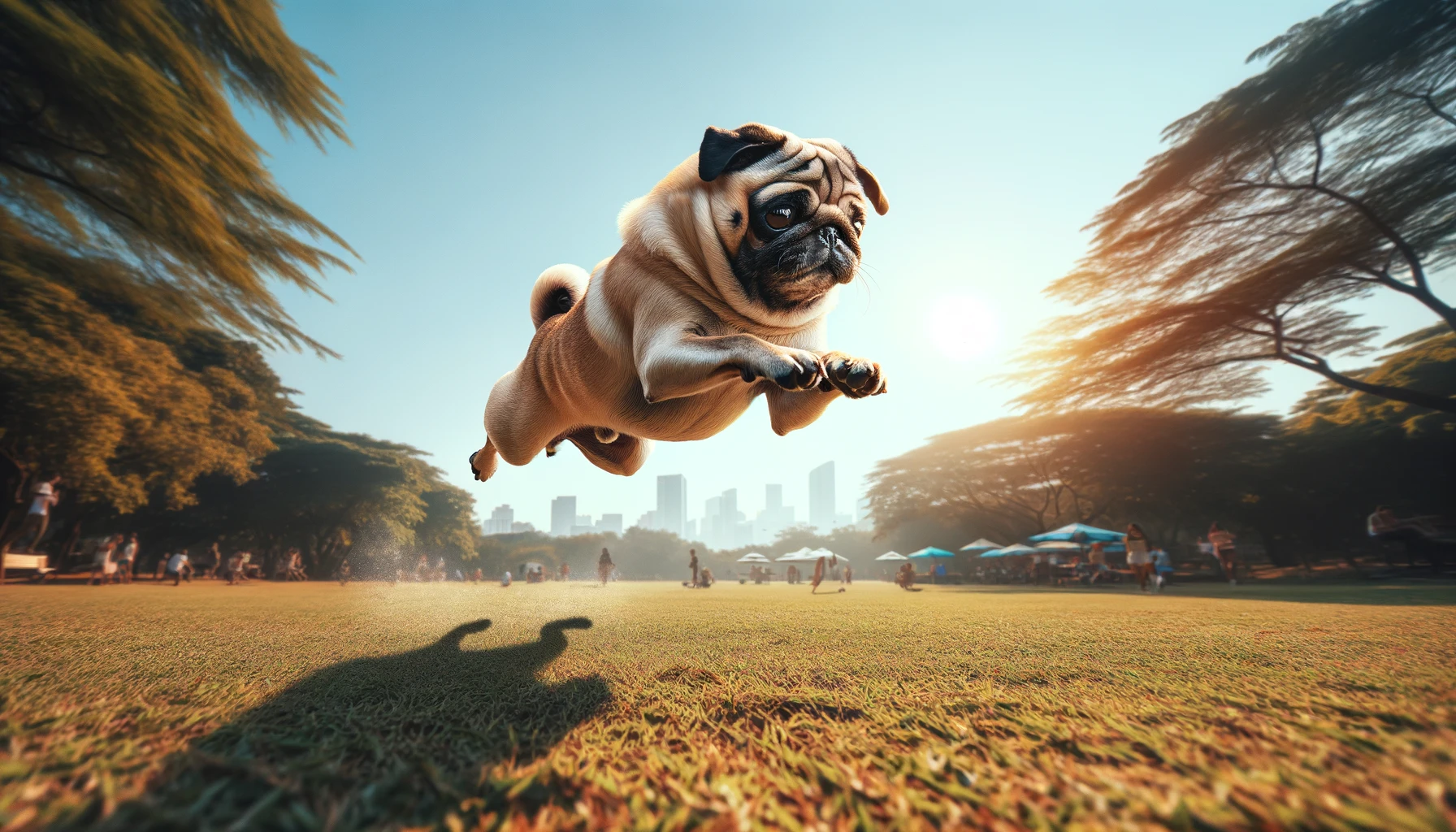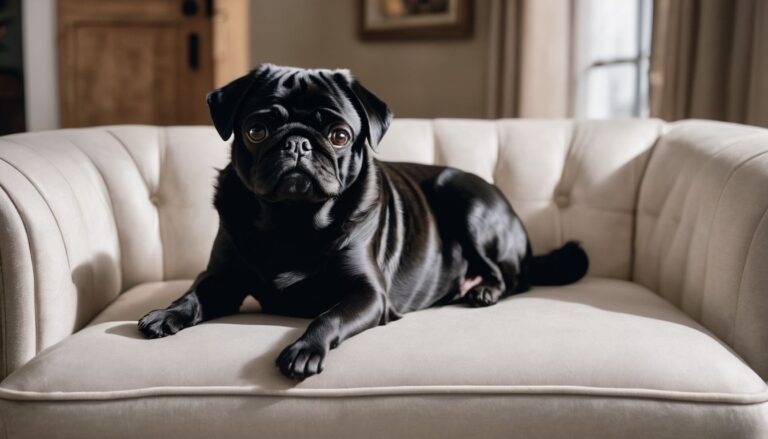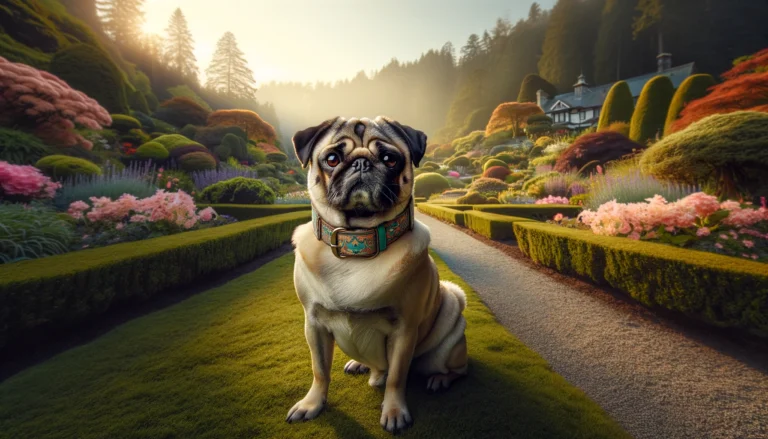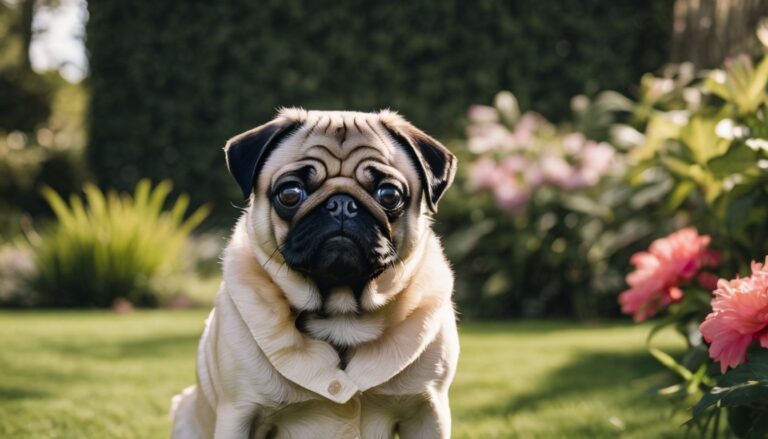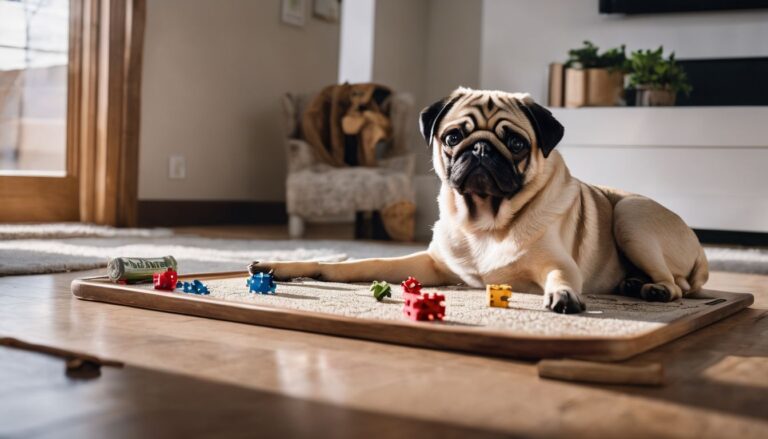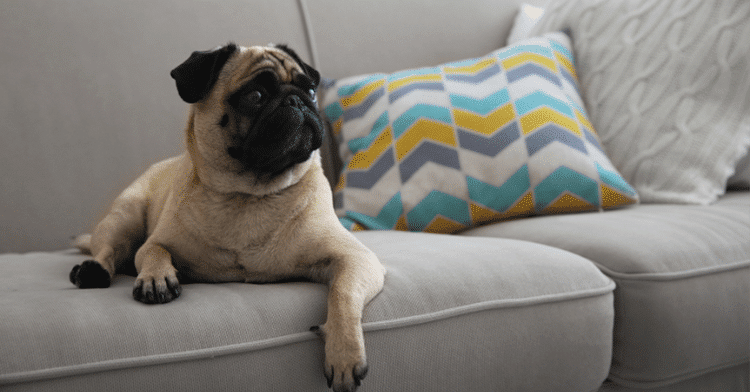The Leaping Legends: Can Pugs Jump?
Can Pugs Jump?
I’ve always found myself curious about the athletic feats of our canine companions, particularly pugs. With their compact bodies and soulful eyes, these dogs often seem more suited to lap cuddles than leaping through the air. Yet, many wonder, can pugs jump? Traditional wisdom might lead us to believe that their short legs and stout frames limit their vertical adventures to a mere few inches off the ground. This belief, however, doesn’t capture the whole picture.
Pugs, known for their playful and enduring spirits, possess a surprising amount of agility and energy for their size. While they’re certainly no match for the towering jumps of larger breeds, these little dynamos can indeed propel themselves to impressive heights when motivated. This capacity for vertical movement plays into both their exercise needs and our responsibilities as pet owners to ensure their safety and well-being.
Key Takeaways:
- Pugs can jump higher than often expected, challenging common perceptions of their capabilities.
- Physical and mental stimulation significantly contribute to a pug’s ability to leap and remain agile.
- Training and safety measures are essential to manage and support their jumping habits effectively.
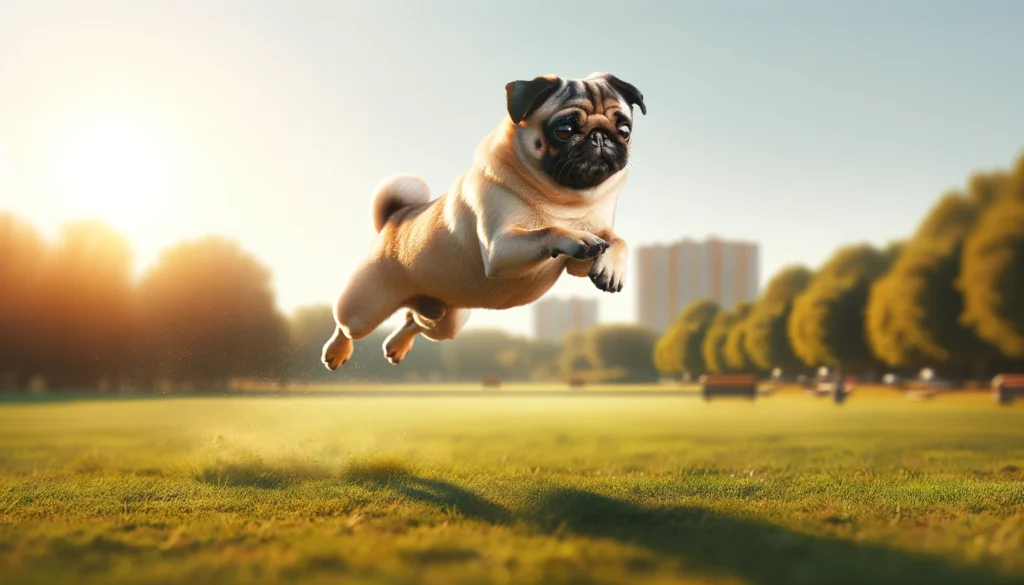
Understanding Your Pug’s Nature
I’ve noticed a fascinating truth about our chubby, short-legged companions. Pugs, with their distinctive faces, carry a bundle of energy and quirks that many of us adore. They’ve carved a special place in the hearts of dog lovers, not through feats of athleticism, but through their endearing personalities.
Recognizing their intrinsic nature became crucial for me, especially in understanding if and how can pugs jump. It helped in understanding the limits and capabilities related to their jumping behaviors. These charming dogs possess a playful spirit, yet their physical makeup does not favor high jumps or extensive periods of rigorous exercise. The joy in their leaps and bounds tells a story of enthusiasm rather than distance or height achieved.
The Physical Limits: How High Can Pugs Jump?
Many of you might wonder, can pugs jump? Truth be told, pugs aren’t the Olympians of the canine world. Most will manage a jump just shy of 3 feet. This figure intrigued me, considering their compact frames and stout legs. Yet, it’s their heart that often wants to soar higher.
Exceptions exist, though rare. Some pugs display surprising bursts of energy and athleticism. These little adventurers challenge the norm, leaping over obstacles you’d never expect. It becomes a testament to their unpredictable nature. Despite their general physical limitations, these dogs occasionally defy expectations, showcasing a spirited determination. This serves as a reminder.
While pugs might not break high jump records, their spirited attempts embody a lesson in never underestimating the underdog.
This lively spirit, nestled within a compact body, demands exercise and mental stimulation. It shapes their behavior, influencing their interaction with the world around them. Considering their unique physical attributes and spirited nature, I tailored activities that promoted their well-being while respecting their limitations. My journey taught me the value of blending pug puppies’ safety with fun, ensuring a balanced environment for these leaping legends to thrive.
Factors Influencing Can Pugs Jump
A pug’s ability to leap isn’t just about their compact size. Energy levels and dog training significantly dictate their jumping prowess. Pugs, known for their playful yet sometimes lazy demeanor, require the right balance of stimulation. Mental stimulation for dogs, coupled with physical exercise, can unleash the latent leaper within. Daily challenges and dog toys are essential. They keep our pug friends engaged and less prone to unwanted jumping habits.
Dog barriers and a well-thought-out space also play a crucial role. By setting up an environment that encourages healthy jumping, we steer clear of potential dog safety issues. Pug puppies, adult pugs, and senior pugs each have unique needs. Tailoring exercise and dog training techniques to fit these stages ensures their safety and well-being. Remember, dog nutrition cannot be overlooked. It fuels their energy, directly influencing their jumping capability. Hence, every meal should contribute to their overall vigor and enthusiasm for life.
Training Your Pug: Encouraging Good Behavior
I have always believed that a well-trained pug is a happy one. Dog behavior has shown us that pugs, like any other dog, require a blend of exercise for dogs, mental stimulation for dogs, and consistent dog training to encourage good behaviors while curtailing the bad ones. Proper dog training involves a mix of patience, consistency, and love.
Firstly, integrating physical stimulation alongside interactive dog toys plays a critical role. These activities not only harness their energy in dogs but also redirect their focus away from undesirable behaviors, including whether can pugs jump out of excitement or boredom. For pug puppies, it’s especially crucial to start young, teaching them the dos and don’ts, including discouraging jumping on people or furniture.
The Importance of Exercise and Mental Stimulation
I’ve always been curious about how exercise and mental stimulation affect whether my pug can jump. You see, pugs carry a reputation for being somewhat lazy, but that’s a bit of a misunderstanding. They possess an energy that can surprise you, especially when it comes to their leaping capabilities. Daily exercise plays a crucial role. It drains their excess energy, making spontaneous jumps less frequent. A tired pug will likely think twice before attempting to soar over the couch or scramble up the bed.
Mental stimulation acts as an invisible leash, keeping their minds focused and bodies grounded. Through dog toys specifically designed for mental engagement, I’ve seen a significant shift. Often, it’s not just about the physical capacity to jump, but also the boredom that pushes them to it. Having something to solve, like a puzzle feeder, means they’re less inclined to practice their high jump routine in the living room. It turns out, that preventing unnecessary leaps starts with a mix of physical exercise and games that challenge their mind.
Furthermore, dog safety is paramount. Thus, setting up dog barriers and understanding dog fences can help manage and guide where and when a jump is safe or allowed. Through these methods, we not only nurture their exercise needs but also ensure they understand their boundaries, embodying well-mannered adult pugs and senior pugs.
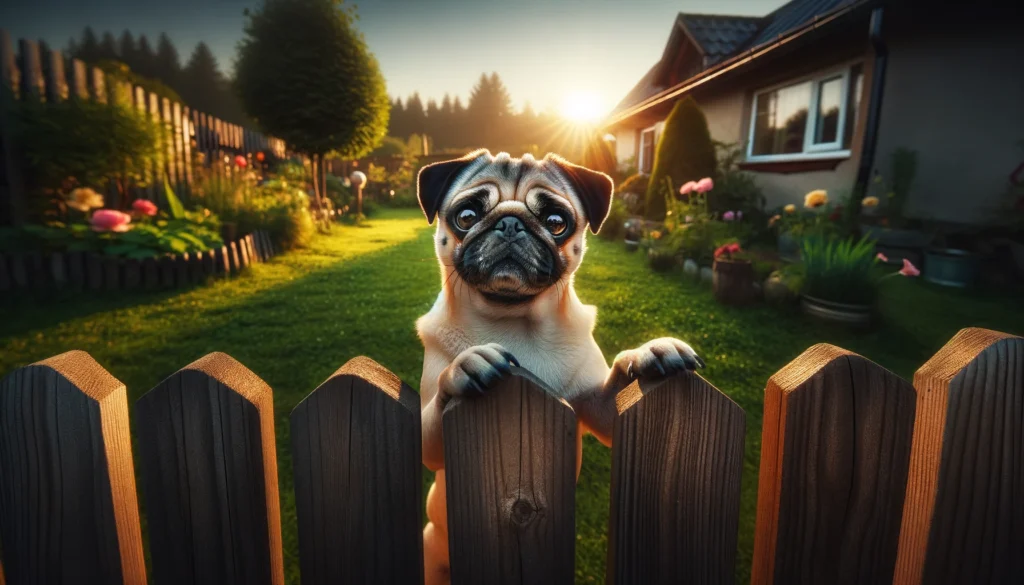
Jumping Over Barriers: Understanding the Risks
Jumping over barriers had always seemed like an adventurous feat for my pug. Our camping portable fence, standing at about 2 feet, presented a challenge. I had thought, wrongly, that pug capabilities, including whether can pugs jump, didn’t extend to clearing such heights. Yet, one day, the sight of my little escape artist on the other side proved me wrong. The risks of such actions quickly became apparent.
Dog safety became my top concern. An injury from jumping or landing could easily hurt my pug’s small frame. Puppies, adults, and senior pugs alike face dangers when leaping without regard for their physical limits. Mental and physical stimulation, coupled with regular exercise for dogs, had become essential in our daily routine to manage this energy responsibly.
To minimize risks, we invested in dog barriers that were pug-proof. Ensuring these were above the jumping capabilities of our furry friend was key. Additionally, dog toys provided an outlet for his energy, and a focus on dog nutrition helped maintain the right energy levels for healthy, safe activities. We learned that creating a secure and stimulating environment was critical for curbing the urge to jump over barriers.
Can Pugs Jump: Age Matters
I learned that age plays a critical role in dictating how high a pug can leap. Can pugs jump? Yes, pug puppies, with their boundless energy and lightweight, manage jumps that might seem ambitious for their size. However, utmost care is necessary. We should encourage only modest jumps to prevent any harm to their developing bones and joints.
Adults, in their prime, display a mix of enthusiasm and strength. Their jumping height averages around 3 feet, provided they remain active and healthy. Exercise for dogs, especially routines involving physical and mental stimulation, ensures pugs maintain their vim without risking injuries.
When our cherished pugs reach seniority, caution becomes the watchword. Jumping habits from their salad days might linger, yet their bodies no longer bear the brunt so willingly. Senior pugs require a gentler approach to physical activity. Dog safety, particularly for our aging companions, means dissuading them from attempts that can hurt them. The focus should be on comfort and preventing strain, with low-impact activities to keep them engaged.
When Jumping Becomes a Problem
Occasionally, a pug’s enthusiasm for jumping, raising the question, “can pugs jump,” morphs from charming to troublesome. This shift often goes unnoticed until a sudden jolt of realization hits us. It’s at this juncture we must pause and evaluate. Our cuddly companions might leap with gusto, but when the jumping interferes with safety, a deeper look is warranted. For instance, repeated attempts to scale dog barriers or fences not only pose a risk of injury but may also signal a plea for more engaging exercises or pug toys to channel their energy.
Moreover, a sudden increase in jumping or a newfound hesitance to leap onto their favorite couch merits attention. These behaviors can illuminate a lack of physical stimulation or perhaps an underlying health concern. It’s also worth considering if our home setup encourages safe exploration.
Proper dog training methods can rectify unwanted leaps, ensuring they understand the boundaries of their abilities and our expectations.
Above all, it’s our responsibility to blend love with firm guidance, ensuring their mental and physical needs are met without stifling their spirited nature.
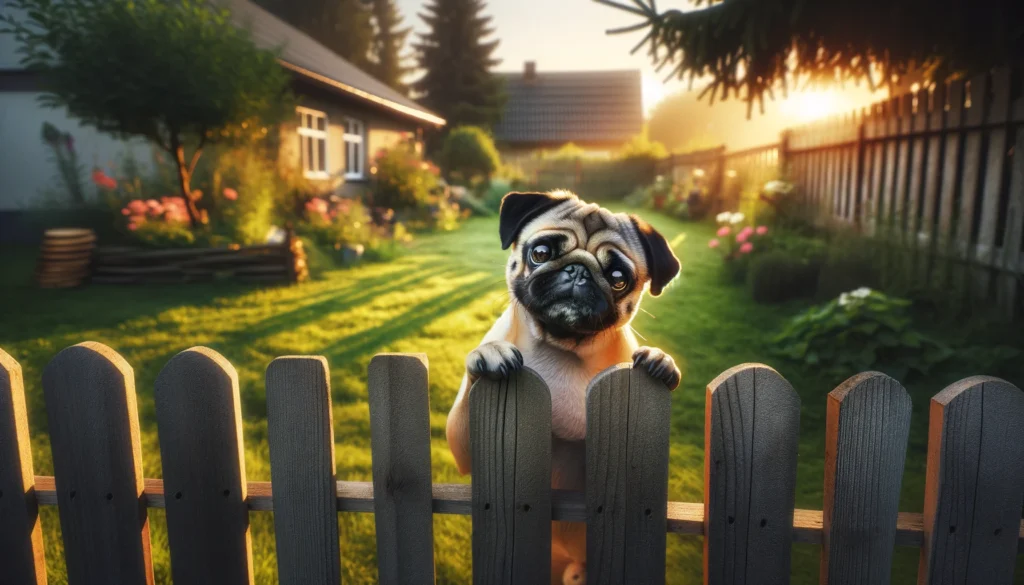
Pug-proofing Your Home
Making our homes safe for our energetic pugs requires a bit of creativity and foresight. Understand their abilities, including can pugs jump, but now, let’s focus on minimizing risks. The right toys play a crucial role in this equation. I’ve found that engaging toys not only entertain them but also discourage unnecessary leaps. Think of puzzles or treat-dispensing items that keep them grounded, literally.
Barrier setups are equally critical for dog safety. I opted for gates that surpass the three-foot mark, a height most pugs can’t easily jump over. This decision came after realizing just how adventurous my little buddy could get. For those with outdoor spaces, ensuring that fences are pug-proof is essential. I’ve seen dogs, full of energy and curiosity, who could find the smallest gaps to squeeze through. Therefore, regularly inspecting these barriers for possible escape routes became part of my routine. Most importantly, going tall with fencing helps keep any potential predators away from Bruce Lee.
Lastly, understanding the nature of our pugs helps us tailor their living environment to their needs. By providing mental stimulation for dogs through carefully chosen toys and constructing physical barriers, we create a setting where jumping doesn’t pose a danger.
All this contributes to a safe, happy home for our beloved pets.
Addressing Laziness and Jumping Reluctance – Can Pugs Jump
Many believe laziness is at the heart of a pug’s reluctance to jump. Yet, we’ll often find that it’s not just about laziness. Pugs, with their compact builds and expressive eyes, sometimes resist jumping for reasons rooted in either physical discomfort or lack of motivation. Excessive weight can be a significant factor, affecting their energy level and overall health. Addressing this starts with a well-balanced diet, ensuring they receive all the right nutrients for optimal energy.
Training plays a crucial role as well. We must create a stimulating environment that encourages our pugs to be more active, questioning whether can pugs jump. Incorporating dog toys in their daily routine can spark their interest and gradually build their confidence in jumping. It’s paramount that we remain patient and consistent with our training methods. Positive reinforcement, rewarding successful jumps with treats or affection, will reassure them that jumping is not only safe but also pleasurable. Over time, the mental and physical stimulation from various activities will naturally dispel any reluctance, transforming them into enthusiastic leapers.
Nutrition’s Role in Your Pug’s Jumping Ability
Every dog lover knows that a pug’s charm lies in its quirky personality and adorable face. Yet, these little dogs pack a punch in energy when properly nurtured. Diet plays a crucial role in determining if your pug resembles more of a couch potato or an agile athlete capable of surprising leaps. Proper nutrition is the fuel that powers not just the body, but also the vivacity of a pug’s spirit.
Pug puppies, adult pugs, and even senior pugs require tailored nutrition for optimal health and vitality. A diet rich in proteins, fats, and the right balance of carbohydrates ensures that your pug maintains the necessary energy levels for activities, including can pugs jump. It’s remarkable how a well-fed pug exhibits higher levels of enthusiasm and stamina. Exercise for dogs, particularly for breeds like pugs known for their propensity towards obesity, becomes significantly more effective when coupled with a balanced diet.
Nutrient-dense dog food not only supports physical activities but also mental stimulation for dogs. It’s fascinating to observe how a nutritious diet can enhance a pug’s responsiveness to dog training, including commands related to jumping and play. Ensuring your pug engages in regular exercise and consumes a diet fitting his lifestyle will inevitably result in happier, healthier, and yes — more agile canine companions. Remember, while dog toys and barriers can aid in managing a pug’s jumping habits, nothing replaces the foundational role of nutrition in their overall capability to leap and bound.
Final Woofs: Wrapping Up Can Pugs Jump
I embarked on this exploration out of sheer curiosity. Could my pug, with its compact frame and joyful demeanor, really master the art of jumping? Throughout our journey, we uncovered fascinating facets of pug behavior, the bounds of their physical capabilities, including if can pugs jump, and the vital role of training. We also delved deep into factors like dog nutrition and the significance of exercise for dogs. At every turn, it became clear: understanding our pug’s nature is key to promoting their wellbeing and safety.
Diving into the depths of pug jumping capabilities proved enlightening. Pugs, often underestimated, possess an ability to leap that surprises many. Yet, their jumps are not without limits. Through the lens of dog safety, we grasped that ensuring secure environments is paramount. The discussions around dog barriers and the necessity to pug-proof our homes stood as a testament to our responsibility as pet owners. Moreover, the narrative around age—highlighting the distinctions in jumping habits from pug puppies to senior pugs—reminded me of the importance of adaptability in our care.
The article served as a conduit to a broader understanding of dog behavior and dog training. Training methods and the allocation of sufficient dog exercise emerged as pillars of preventing excessive jumping. Such endeavors not only keep our furry friends grounded but also sharpen their minds. The emphasis on mental stimulation for dogs became an anthem sung in unison with the melody of physical stimulation. And let’s not forget the indispensable role of dog toys in enriching their lives. However, it’s our shared moments, those tiny victories in training and the joyous leaps (within safe limits), that cement our bond with our pugs. May we continue to cherish and nurture their spirited antics, ensuring they leap—not just physically, but into our hearts—safely and joyfully.

